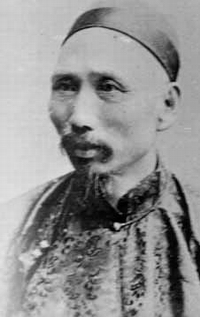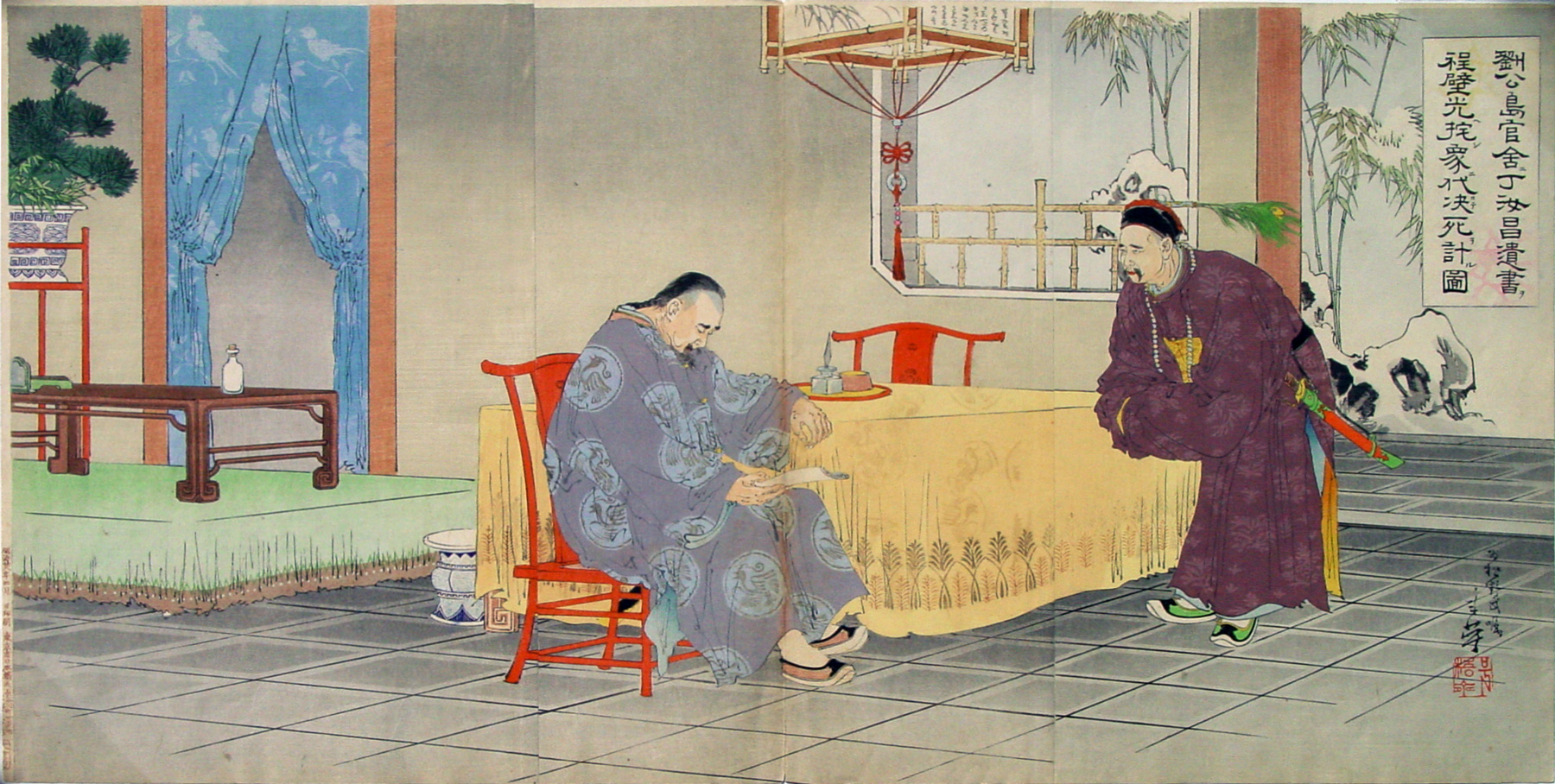About This Print
Chinese Admiral Ting Ju ch'ang (Ding Ruchang)
Source: "Prints of the Sino-Japanese War," Donald Keene, Impressions of the Front: Woodcuts of the Sino-Japanese War, Shunpei Okamoto, Philadelphia Museum of Art, 1983, p. 9.
 Dīng Rǔchāng (1836-1895) | “Shortly after he surrendered, the Chinese admiral Ting committed suicide, a sure way to earn respect in Japan. [Toshihide’s print] shows a much heavier and older Admiral Ting, slumped in his chair, with the vial of poison on a nearby table, as he reads over his final testament. Though anecdotal and in a style that had lost popularity in Europe, it is curiously moving, precisely because of Toshihide’s ability to convey at once the grief and dignity of the defeated man. Defeat, not victory, is the theme of most of the medieval Japanese war tales, and the heroes of Japanese history are mainly failed heroes. Perhaps that is why the dying bugler Shirakami Genjiro and the defeated Admiral Ting are the most distinctive figures among all those depicted in the Sino-Japanese War prints.” |
Background
Naval Battle of Wei Hai WeiSource: The Sino-Japanese War of 1894-1895: Perceptions, Power and Primacy, S. C. M. Paine, Cambridge University Press, 2003, p. 98-100.
The land and sea attack on Wei Hai Wei (Waihaiwei) by Japanese forces lasted twenty eight days from January 20 through February 16, 1895. It is considered the last major battle of the Sino-Japanese War. The deciding sea battle began with heavy shelling on February 3 and by February 9 the Chinese fleet of 20 warships was reduced to four vessels and a few gunboats by a much larger Japanese force. Within a few days Chinese Admiral Ting had surrendered to Japanese Admiral Ito.
The Surrender of Admiral Ting
Source: The Sino-Japanese War of 1894-1895: Perceptions, Power and Primacy, S. C. M. Paine, Cambridge University Press, 2003, p. 107.
To His Excellency Ito, Commander–in-Chief of the squadron.
"…having fought resolutely, having had my ships sunk and my men decimated, I am minded to give up the contest, and to ask for cessation of histilities in order to save the lives of my people. I will surrender to Japan the ships of war now in Wei-Hai-Wei harbour…"
(Signed) Ting Zhuchang, Tituh of the Peiyang Fleet
(Dated) 18th day of the 1st month of the 22nd year of Kawag-su (February 12, 1895)
The Suicide of Admiral Ting
Source: The Sino-Japanese War of 1894-1895: Perceptions, Power and Primacy, S. C. M. Paine, Cambridge University Press, 2003, p. 100.
"After thanking Admiral Ito for saving the lives of his men, he wrote a telegram to Viceroy Li-Hung-Chang, withdrew to his quarters and committed suicide…"
To His Excellency Ito, Commander–in-Chief of the squadron.
"…having fought resolutely, having had my ships sunk and my men decimated, I am minded to give up the contest, and to ask for cessation of histilities in order to save the lives of my people. I will surrender to Japan the ships of war now in Wei-Hai-Wei harbour…"
(Signed) Ting Zhuchang, Tituh of the Peiyang Fleet
(Dated) 18th day of the 1st month of the 22nd year of Kawag-su (February 12, 1895)
The Suicide of Admiral Ting
Source: The Sino-Japanese War of 1894-1895: Perceptions, Power and Primacy, S. C. M. Paine, Cambridge University Press, 2003, p. 100.
"After thanking Admiral Ito for saving the lives of his men, he wrote a telegram to Viceroy Li-Hung-Chang, withdrew to his quarters and committed suicide…"
Other Prints in Collection Depicting the Battle of Weihaiwei
Viewing the captured chinese warship Chinen at Yokosuka Naval PortPicture of the occupation of the Hodai Fort, at Wei-Hai-Wei by our 2nd Army
Picture of the violent battle in the snow in the Toshu Province near Wei-Hai-Wei
Picture of the Attack on the Battery at Weihaiwai
Print Details
| IHL Catalog | #92 |
| Title or Description | Chinese Admiral Ding Ruchang about to Commit Suicide after Surrendering to Japanese Forces 劉公島官舎ニ丁汝昌遺書ヲ程壁光ヘ托シ衆ニ代リテ決死ヲ計ル図 |
| Artist | Migata Toshihide (1863-1925) |
| Signature |  |
| Seal | Gōsai in (see above) |
| Publication Date | 1895 (Meiji 28) |
| Publisher |  |
| Impression | excellent |
| Colors | excellent |
| Condition | good - three panels joined; backed; vertical center fold; minor soiling; minor trimming barely into image long right and bottom sides |
| Genre | ukiyo-e - senso-e (Sino-Japanese War); Meiji era |
| Miscellaneous | |
| Format | vertical oban triptych |
| H x W Paper | 14 1/2 x 28 3/8 in. (36.8 x 72 cm) |
| Literature | Japan Awakens: Woodblock Prints of the Meiji Period (1868-1912), Barry Till, Pomegranate, 2008, p.111; The Arts of Meiji Japan 1869-1912: Changing Aesthetics, Barry Till, Art Gallery of Greater Victoria, 1995, p. 103, pl. 1.51. |
| Collections This Print | Art Gallery of Greater Victoria 1995.011.002 a-c; National Diet Library 寄別8-5-1-2 (included in a bound volume of S-J War prints) |


